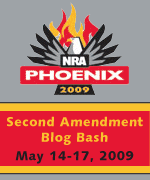Michael Bane, in his efforts with the National Shooting Sports Foundation (NSSF), is seeking ways to maintain and grow the shooting sports. One of his discussions has included the need for more shooting ranges to allow more people to safely enjoy the shooting sports in a safe and responsible environment.
Ben Avery Arizona Shooting Range Facility and Rio Salado Sportsmen’s Club are world class shooting ranges. Our Arizona Game & Fish department receives no funding from Arizona’s general fund, yet Ben Avery has a five-star rating from the National Association of Shooting Ranges and is the first government facility to receive this designation.
The Goldwater Institute in Scottsdale, Arizona has a new commercial pushing the Arizona legislature to “fix it’s spending priorities” by confiscating the full $800,000 in shooting range maintenance money budgeted by Arizona Game & Fish Department. Arizona has budget problems due to overspending. When politicians run out of tax money to spend, they often look to raid successful programs. An increase in the state sales tax has been proposed, but the Institute advocates raiding a self-sustaining agency’s funds, gutting an effective program and reducing it to the mediocrity of other government programs.
How do they get the tax money to operate?
While the average person has no idea how the outdoors are managed in Arizona, most of us paying user fees and membership dues to shoot at Arizona’s acclaimed ranges know that our money goes directly to the maintenance of those ranges, as well as wildlife management. In fact, many people buy fishing licenses, hunting licenses, and game stamps just for the purpose of supporting the activities of the Arizona Game & Fish Department.
Even if you don’t buy hunting or fishing licenses, when you purchase firearms and ammunition, you pay Federal Firearms and Ammunition Excise Taxes of 10% for pistols, 11% for rifles and bow hunting equipment, and 11% for ammunition. The Federal Aid in Wildlife Restoration Act of 1937, also known as the Pittman-Robertson Act, established this tax and requires that the funds collected are placed in a special trust by the Fish and Wildlife Service under the Department of the Interior. This money is then distributed back to states in matching grants for wildlife conservation, wildlife management, habitat restoration, wildlife research, hunter education, and shooting ranges.
One of the conditions on Pittman-Robertson funds is that states are prohibited from diverting hunter license fees:
(States shall) make laws governing the conservation of wildlife, shall have assented to the provision of this chapter and shall have passed laws for the conservation of wildlife which shall include a prohibition against the diversion of license fees paid by hunters for any other purpose than the administration of said State fish and game department…
Smart politicians knew that some day, a state pinched for money would view outdoor sporting programs as a cash cow they would milk to death, using sporting monies to cover up for excessive spending on other programs. Fortunately, our outdoor user fees are protected by both State, and Federal laws.
How does it work without State tax revenues?
Arizona Game and Fish is a self-supporting, “business-model” agency, generating it’s own funding for survival, unable to feed off of tax dollars in Arizona’s General Fund. The model is based on the same “user pay, user benefit” model that is the basis for the Pittman-Robertson Act. Arizona Game & Fish must provide excellent services to outdoor sporting enthusiasts, or close up shop, just like any other business.
If our Game & Fish department doesn’t provide proper wildlife management or charges too much for hunting license, hunters will go elsewhere or quit the sport, depriving the department of funding. If they neglect the shooting ranges, users will find other places to shoot, taking their money with them. In other words, they have to sing for their supper to get funds from shooters, hunters, anglers, boaters, and OHV owners through licenses, user fees, and motorboat and OHV gas taxes.
Arizona Game and Fish needs participants in outdoor activities to pay user fees, so that they can get those matching grant dollars from the Pittman-Robertson Act, as well as similar Federal Aid in Sport Fish Restoration Act funds from taxes on fishing gear. The Federal funds returned to Arizona by these two programs increased the Game and Fish budget by $20,885,600 in 2009. Every customer Arizona Game and Fish gains will generate significantly more funding than just the use fee. Each loss of a customer magnifies the loss wildlife management funds. The result is in a government agency that treats the people that fund it as customers, instead of subservient peasants.
Arizona Game and Fish also holds an Outdoor Expo every year to introduce people to Arizona outdoor recreational activities they otherwise would never have the opportunity to try. Mz. VRWC learned the basics of shooting at the 2009 Expo and has worked diligently to pay for the experience by buying quite a few guns, buying ammo, becoming a range member, and paying for training at Arizona shooting ranges.
One of the amazing things that happens with a model like this is, people voluntarily pay money to Game and Fish, when they could just as easily spend their money elsewhere. In fact, non-profit organizations hold auctions and other fundraising activities to help fund outdoor activities through additional matching grants and gifts, as well as providing volunteers for activities like shooting range maintenance.
The Arizona Elk Society, the NRA Foundation, the Friends of NRA groups, and numerous other groups raise money and provide grants to Game and Fish for wildlife management, hunter education, gun safety training, shooting range maintenance and construction. How many other government agencies provide services so valuable that recipients happily donate their own time and money back to the agency?
What happens if a state takes outdoor sports money away?
If the state starts raiding the Game and Fish money, most likely we would lose all of the $20,885,600 Arizona receives through the Pittman-Robertson Act and Federal Aid in Sport Fish Restoration Act. Additional state taxes would need to be raised in order to carry out Federally mandated wildlife management and restoration activities. Shooting ranges would probably close due to disrepair and safety issues, while law enforcement departments would have to build their own shooting ranges, or forgo firearms training for officers.
Nonprofit and private donations of time and money to the Game & Fish would probably disappear too. Here’s a few examples of recent grants and donations that would probably disappear:
The Tonto Rim Sports Club Jim Jones Shooting Range received a $11,500, as a gift from the Zane Grey Committee’s Friends of NRA, for range repairs and improvement. March 16, 2010
Arizona Game and Fish Department offered a $25,000 grant for improvements at the Elzy Pearson Rifle Range in Casa Grande, provided matching funds were raised. Friends of NRA provided the matching $25,000.
Arizona Friends of the NRA (National Rifle Association) and the NRA Foundation recently awarded the Arizona Game and Fish Department $16,000 in grant funds to purchase shotguns and small caliber rifles, which will be used by certified instructors to teach firearm safety and introductory target shooting programs to youth. March 14, 2008
Volunteers put in more than 500 hours to refurbish the High Power Rifle Range at Ben Avery Shooting Facility
Arizona has received 235 grants from the NRA Foundation totaling $1,533,073 from 1992 to 2007.
Why should a state fund a shooting range?
Under the Arizona model, the State doesn’t fund shooting ranges, they merely approve, or disapprove, the budget plan created by the Arizona Game and Fish Commission. The users, along with non-profit organizations pay for the ranges. A great reason for a state to encourage the development of shooting ranges is the creation of multi-use facilities for law enforcement training, civilian marksmanship training, hunter education, and competition use. Shooting competitions and firearms training attract tourist dollars too.
One way our state reduces the tax burden is through the sharing of the shooting ranges with law enforcement. If we didn’t share the ranges, each municipality would spend millions to create a shooting range for each law enforcement agency. Under our system, the Tempe Police pay a modest fee to use the Rio Salado Sportsmen’s Club shooting range for officer firearms training, practice, and firearms qualification testing. The Maricopa County Sheriff’s Office uses the Ben Avery Arizona Shooting Range. Public ranges in Tucson are used by the Tucson Police, US Border Patrol, and by the military.
President Ronald Reagan stated it best on the 50th Anniversary of Pittman-Robertson when he said, “Those who pay the freight are those who purchase firearms, ammunition, and, in recent years, archery equipment.” These shooting range facilities provide wonderful public services, placing no financial burden on disinterested taxpayers, while improving public safety and recreational opportunities. I’m proud of the service, accomplishments, and effectiveness of the Arizona Game and Fish Department. I believe they are a model government agency that should be emulated elsewhere, whether to increase outdoor recreational opportunities, or to build additional shooting ranges without unfairly burdening people who would never use the facilities.
For additional information on how Pittman-Robertson funds are used for Range Development, please see http://www.nrahq.org/shootingrange/pitmann.asp The Federal Aid in Sport Fish Restoration Act taxes fishing gear and provides matching grants in the same fashion for managing state fishing programs.




